Ever browse a website and walk away even more confused about what the heck the company does or who they do it for? Does it seem like they try to cram as many trendy keywords or topics in, all while completely distracting visitors from how, or even if, they solve a problem? Or maybe they did a great job on one page, only to baffle or disorient you on another.
What if it’s your website that’s puzzling visitors?
If it takes seven seconds to make a first impression, you’ve lost your audience at the top of your sales funnel with little chance of recovery.
It may be time to step back and gain some clarity on your core messaging before cranking out another piece of content. It’s time to build a message framework.
What is a Message Framework?
A message framework gives structure to how we clearly articulate our value and differentiation to target audiences. It provides a consistent set of themes that reflect the brand, tone, and voice so communicators, marketers, sales, and content developers can speak and write with consistency and focus. It runs across everything an organization does and every piece of content and communication it shares.
Distilled into a useful framework, it should provide a high-level anchor statement or value proposition and 3 or 4 supporting themes. Those themes should be strengthened with relevant proof points, stories, metrics, and anything that support the application of that theme for content development.
When Do We Need to Think About It?
There are numerous opportunities to consider your strategic messaging.
For new companies such as startups, this should be an exercise to consider sooner rather than later. Competition is fierce and many markets saturated, so it’s imperative to quickly and clearly articulate what your business does and how you solve a problem.
With established brands and organizations, there are various events and triggers that would justify a message refresh. Corporate activities such as M&A, reorganizations, new leadership, new solutions, products, or services, a rebranding, a website redesign, and a host of other major events, could constitute a message overhaul and the opportunity to build a message framework.
It’s also a consideration for smaller activities such as participating in industry events, running campaigns, agile content marketing, and content sprints. A framework specifically for these actions can mean the difference between success or failure.
Why Is It Important?
Establishing key themes and anchor messages to build communications and content is vital for your brand and its reputation. Providing consistency across the organization so that everyone speaks to the same priorities and differentiators ensures people are always clear on who you are, what you do, and how you do it. If the people mostly interacting with your customers are speaking in disparate terms about your business, there will be nothing but the confusion that distinguishes you.
Without a strong message framework to build from, your project or initiative runs the risk of failure with missed opportunities, confusion to your core audience sets, misdirected or misaligned content distribution, and ultimately, damage to your brand.
How It’s Applied
Once you build a message framework, the various elements become the foundation for content and communication development.
Beginning with a content strategy, the message framework can quickly determine the purpose, direction, and goals of your content efforts. It removes ambiguity and cuts through competing priorities to gain agreement on focus and mindshare.
The same goes for your communications strategy. Ideally, content and communications professionals are in sync and the framework provides both teams a consistent and focused set of priorities to concentrate efforts and to anchor their programs.
Good messaging is used for every content and communication needed to support these efforts. From press releases to client communications, web copy to sales presentations, brochures to social media posts, and so on. It all starts with clarifying and articulating the message.
The message framework provides the ultimate direction for all your content and communications activities.
DISCOVERY PHASE
 Pixabay
Pixabay So how do you figure out what the right messages are?
There are numerous places to seek insights and there is no one singular place you’ll find the answers. Seasoned professionals are quite used to hunting in all corners in and out of the organization and intuitively begin to spot the key themes that consistently emerge. They may not always appear with the same words and language, so it takes practice and an open mind to see broadly and to connect the dots.
Where to Start
First, let’s understand the two components of the framework you’ll be developing.
Anchor Statement or Value Proposition
The first thing you want to understand and confirm is the value proposition. This is your anchor statement for the framework. The anchor statement is the primary stake in the ground of what your company does better than anyone, who they do it for, and how they deliver. At a high level, it should answer what problems you’re trying to solve.
Core Themes
Next, you’ll want to explore the core themes. Usually, you’ll want to stick to three, but you could potentially have up to five, depending on your business. These will fall out of or align to the anchor statement, but the themes are focus points that underscore or reinforce the statement.
Now you need to put in the hard work with research, interviews, and information gathering.
Depending on what layer or level within the organization you’re creating the framework for, that will drive the best places to seek inputs.
- Look to the Top: If you’re creating a framework for the organization as a whole to communicate company information and executive communications, you look to the most senior leadership. There’s likely an annual business plan and company goals that will provide a wealth of information about where priorities and dollars will be concentrated. If this is still under development, go to the source and start speaking with the C-level executives who are responsible for the creation of those plans. If they haven’t put pen to paper just yet, I guarantee they are thinking about core priorities so they can direct resources and budgets.
- Seek the Innovators: If you have an in-house R&D organization or teams, talk to those people as they’re typically a hotbed of ideas on what’s important and where efforts should be focused.
- Interview the Front Line: If you’re creating a framework for a layer down, within business units or teams, again, look to business plans, team plans, sales plans, and speak to the leadership teams for more insights. These are the people that are out talking to clients every day, they see what the business needs, they are shaping the services, solutions, and products within the company—they can shed light on the aspirational goals of their respective areas as well as where the biggest opportunities are.
And work your way through the organization depending on where your initiative is focused. If it’s a campaign, dive deep within the focus of the campaign. Talk to the subject matter experts and sales teams, explore the work that’s already been done with clients, scan any existing content assets, and so on.
- Go Outside: Have you reviewed feedback from customers? Take a look at any CSAT survey results. Look to see what industry analysts and competitors are saying within that space. Go to top media and publications and look at the latest articles being published to see what they’re talking about. What key themes or areas of concentration emerge within your industry or space when you read through these invaluable resources?
What to Look For
We’ve started to allude to what you’re looking for when you review all the resources available, but let’s get a little more specific.
You’ll probably notice that you start to hear recurring themes about what’s important, what you do well, or where you hope to drive some visibility. Get great at identifying themes—it’s a fantastic skill to have and you’ll leverage it often.
Some of the themes you might see will fall under the guise of a large and likely general concept. For example, many organizations talk about innovation as a priority. I can almost guarantee that you’ll hear this pop up on more than a few occasions as you talk to various resources. What you’ll need to extract from that is what they mean by innovation and whether they have ideas for how, where, in what way, or any other distinctions that can drive a clearer more focused priority.
A better example might be, “innovation within the customer experience.” Even that can be considered vague, but it does narrow the focus. To gain even more clarity, you could go on to say, “innovation within customer experience through a client ambassador program.”
Build a Message Framework: Capture, Test, Share…and USE!
 Pixabay
Pixabay Once you’ve exhausted all your sources and extrapolated recurring themes, it’s time to distill them down into your framework components and test them with key stakeholders and leaders. You want to be sure you’ve captured the essence of the value the organization brings, and you want to make certain statements and themes resonate with those who will use the most.
Download our Message Framework TEMPLATE to capture your new messaging and build a message framework.
After testing and refining, be sure to share your framework with every internal leader, group, team, and the individual who will have any responsibility for developing content, communications, and marketing materials for your business.
After all, it only works if everyone actually uses it.


Pingback: How to Build a Meaningful Strategic Messaging Platform as a Leader – Courtside Leadership